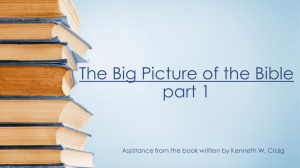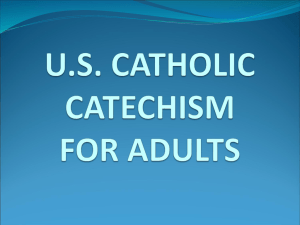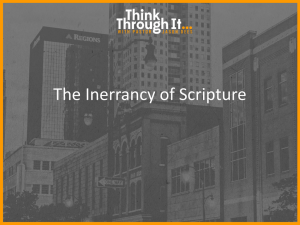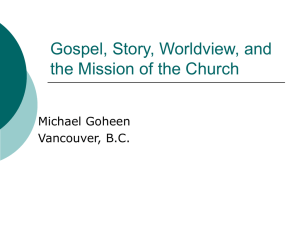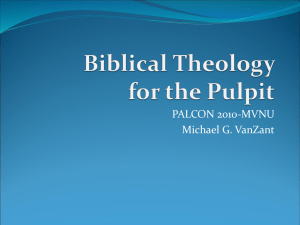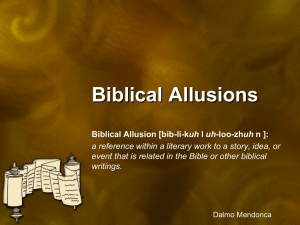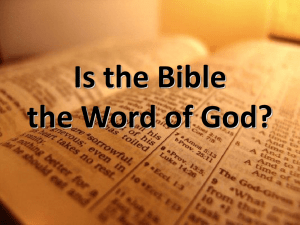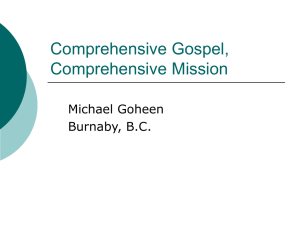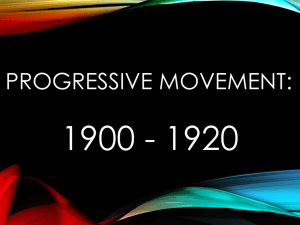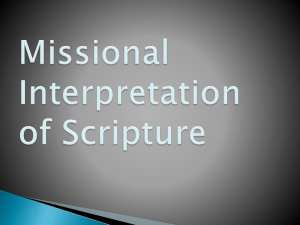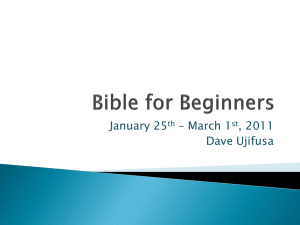THE AUTHORITY of the BIBLE in the CHURCH
advertisement
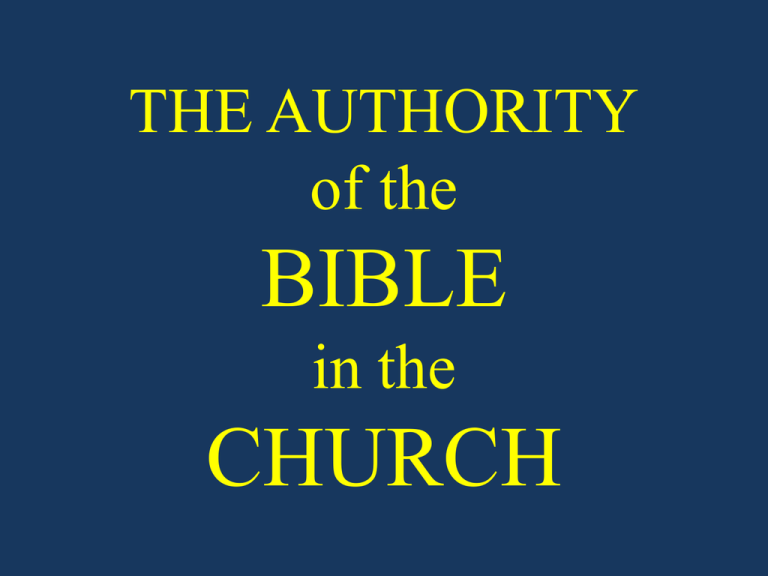
THE AUTHORITY of the BIBLE in the CHURCH I. Historical Perspective 1. The New Testament Church • No completed ‘New Testament’, but... • (a) Torah, Prophets, and Writings • (b) The Gospel: ‘Before there were the Gospels, there was the gospel’ (Donaldson) • The ‘word’ of preaching (kerygma) – see Acts • I Cor. 15:3ff.: “That Christ died for our sins according to the Scriptures, that he was buried, that he was raised on the third day according to the Scriptures, that he appeared to [witnesses]” • Acts 2:36: ‘This Jesus whom you crucified God has made both Lord and Christ’ • Basic two-in-one shape of the gospel (euangelion): • the Crucified One is Risen! • But there is more: • ‘Being exalted at the right hand of God, and having received from the Father the promise of the Holy Spirit, he has poured out this which you see and hear’ (Acts 2: 33) • The basic shape of the narrative of the gospel: • not only Christ-centred, but Trinitarian • This gospel is the presupposition of every NT book • The gospel is proclaimed by the apostolic witnesses • I Cor. 15: 5f.: Cephas... the Twelve... the 500... • Acts 1: 21f.: ...one of those who have accompanied us all the time that the Lord Jesus... until the day he was taken up... a witness to his resurrection. • The authoritative witness of the apostolic generation • Authorized by the Risen Lord (Matt. 28:18, Mk 16:15; Lk 24:47f.; Jn 20:21f.; Acts 1:8) • The Apostles continued authority is exercised through their writings – the ‘New Testament’ • Their use of what now became the ‘Old Testament’ • The authority of the Bible is the authority of the Apostles given to them by the Lord Jesus 2. The Ancient Catholic Church (from c. AD 100) • Only the apostolic writings to be read in worship (leitourgia) • Gradually developed a list or ‘rule’ (canōn) of books throughout all the churches • But along with that went the ‘rule of truth/faith’ (canōn tēs alētheias → regula fidei) • Embedded in worship i.e. in sacrament of baptism: • “into the Name of the Father, the Son, and the Holy Spirit” (Matt. 28:19) • in other words... The story of the gospel! • The ‘rule of faith’ is the Trinitarian story of the gospel (euangelion → evangel) • Confession of faith before baptism • The ‘rule of faith’ developed into the creed (credo): • “I believe in God the Father Almighty, Maker of heaven and earth, and in Jesus Christ his only Son, our Lord, who was... [the two-in-one shape] ... And in the Holy Spirit...” • This was ‘handed on’ (trado) → Tradition • Succession of episkopoi/prebyteroi • Authority lay in the apostolic Scriptures as interpreted by the creed [i.e. the gospel!] handed on in the tradition in the Church • Scripture + Tradition 3. The Reformation • The rediscovery of the gospel (euangelion): • Paul → Luther (“I am not ashamed of the gospel... ‘The just shall live by faith’”) • Die Evangelische Kirche • “Evangelical Theology” centres on the gospel • Christ-centred (solus Christus) • Cross and Resurrection (‘the crucified One is risen’) • Trinitarian: the narrative of the Father, the Son, and the Holy Spirit • Sola fidei.... Sola gratia... a solo Christo... The problem was with later tradition: • Purgatory → Indulgences • The mass: transubstantiation - the ‘magical’ power of the priests • ‘Grace’ a substance infused into us by the sacraments • controlled by the priests! • The authority of the pope and the hierarchy • The Evangelical Reformers: • Tradition versus Scripture • Sola Scriptura The Thirty-Nine Articles (Church of England) Article VI: Holy Scripture containeth all things necessary to salvation: so that whatsoever is not read therein, nor may be proved thereby, is not to be required of any man, that it should be believed as an article of faith, or be thought requisite or necessary to salvation. Article IV (Nazarene Manual) We believe in the plenary inspiration of the Holy Scriptures, by which we understand the 66 books of the Old and New Testaments, given by divine inspiration, inerrantly revealing the will of God concerning us in all things necessary to our salvation, so that whatever is not contained therein is not be enjoined as an article of faith.’ • Sola scriptura 3. The Enlightenment • Scripture versus ‘Reason’ • Deism – based on scientific reason (Newton) • Natural Theology: proving God’s existence from ‘Nature’ – argument from ‘design’ • But Biblical story marginalized, i.e. – The Incarnation: Christ, divine and human – The Atonement: that He ‘died for our sins’ – The Trinity: Father, Son and Holy Spirit • Deism and moral order - sanctions 4. The Nineteenth Century • Scripture versus Experience (a) Romantic Movement • Schleiermacher: all humanity has ‘religious’ experience • Build Theology on ‘Religion’ not the Biblical revelation • Christianity the most advanced ‘religion’ • Result: so-called ‘Liberal Theology’ (b) Biblical Criticism • The historical-critical method • Date and authorship of the Biblical books • ‘What really happened’: the history behind the text • But ‘Naturalism’ was presupposed • i.e. a closed system of cause and effect without divine ‘intervention’ • Said to be ‘scientific’ • Actually Deism (c) Scientific Developments • Darwin: –Fixity of the Species; uniqueness of humankind –Age of the earth –Question of the Fall – Bible versus Science (‘Conflict Thesis’) –T.H. Huxley → Secular Humanism • Freud: Behaviourism → B.F. Skinner • Marx : economic determinism To sum up the nineteenth-century developments: • Liberal Theology turned from Scripture to religious experience: the Bible was a human book through which God spoke • Biblical Criticism, informed by ‘Naturalism’, rejected the miraculous in the Bible • Scientific developments posed questions about the interpretation of the Bible Reformation/Evangelical View Today Mainstream Evangelicalism • Broad coalition – Anglicans, Methodists, Calvinists, Arminians, Baptists, Lutherans, Nazarenes, etc. etc. • Roots back to Reformation and to C18th Revival (a) Final authority of the Bible (sola scriptura) (b) Validity of the historical-critical method (c) Hermeneutics (d) Compatibility of faith and science • Fundamentalists tend to reject (b), (c) and (d) (a) Final Authority of the Bible (sola scriptura) But division on ‘inerrancy’: 1. Those who espouse ‘inerrancy’ • Bible ‘inerrant’ on history and science as well as doctrine and ethics • strongly apologetic Reformed tradition • inerrant Bible as epistemologically prior • deductive method: doctrine of God • American: ETS, Wheaton, TEDS, etc • But what constitutes an ‘error’? 2. Those who prefer ‘infallibility’ • Bible ‘infallible’ (= final authority) on doctrine and ethics • The biblical history may be shown to be substantially accurate • Apparent minor discrepancies insignificant • Not prior to, but implied in, faith in Christ • Inductive method: start from the phenomenon o scripture • Europeans, Fuller, Intervarsity, more typical of Anglicans, Wesleyans, etc. • ‘…the Holy Scriptures… given by divine inspiration, inerrantly revealing the will of God concerning us in all things necessary to our salvation, so that whatever is not contained therein is not be enjoined as an article of faith.’ • 1928 General Assembly • Drafted by H. Orton Wiley • Uses the word ‘inerrantly’ to express the Bible’s infallibility on faith and practice (b) Validity of historical-critical method: • Westcott, Lightfoot & Hort, Robertson Smith, F.F. Bruce, G.E. Ladd, Donald Guthrie… • Today: I.H. Marshall, Earle Ellis, N.T. Wright, Anthony Thiselton, Richard Hays, Francis Watson, Richard Bauckham, H.G.M. Williamson, Robert Gordon, R.E. Clements, Gordon Wenham, Ben Witherington, Joel Green, etc, etc, etc • But a new focus on the text itself (c) The Necessity of Hermeneutics • Unavoidable! • If you don’t want to interpret the Bible, don’t preach. Just read the passage! • Fundamentalists and some evangelical inerrantists have resisted this • Anthony Thiselton • A new interest in integrating biblical studies and theology (Childs, Watson, Green, etc, etc) (d) Compatibility of Biblical Christianity with modern science • The ‘conflict thesis’ of Huxley and Humanism is historically wrong • Each level of knowledge (science and theology) must be respected • Creatio ex nihilo is not a scientific theory (as ‘Creationists’ think), but a doctrine of the faith • Contemporary cosmology (the ‘Big Bang’) is more compatible with Xty than Newtonian Cosmology • Hermeneutics: Genesis 1 is a ‘hymn of creation’, i.e. it is not the genre of scientific description but of poetry • Creation and the Fall not open to historicscientific study • Creation as the beginning of time, and the Fall as a temporal event (within time) The Wesleyan View Nazarenes Today: 1. Many lay people influenced today more by popular fundamentalist preachers than by our own Wesleyan tradition. 2. Church leaders and theologians stand as Wesleyans with the ‘infallibility’ position of Art. IV shared by mainstream evangelicals. The so-called “Wesleyan Quadrilateral”: (Albert Outler – but now debated) • Scripture • Tradition (Reformation: Scripture v. Tradition) • Reason (Enlightenment: Scripture v. ‘Reason’) • Experience (19th C: Scripture v. Experience) • Yet we need Tradition, Reason and Experience • But these are not equal factors! • Timothy L. Smith: the three-legged stool DOCTRINE REASON TRADITION S C R I P EXPER IENCE T R U E In other words: We (the Church) interpret Scripture – using our reason – in the light of our spiritual experience – guided by tradition – to formulate doctrine This means that the Wesleyan Quadrilateral is not contrary to sola scriptura… The Word of God in the Bible is the source of doctrine, but interpreted through these three. The Hermeneutical Circle SCRIPTURE [Text] DOCTRINE [Interpretation] The authority of the Bible in the Church is the authority of the apostolic witness to the Crucified and Risen Lord. The apostolic generation were centred in the Twelve, given authority by the Lord himself to be his witnesses, and they were guided in this by the inspiration of the Holy Spirit. The gospel which they preached gave the scriptures which they wrote unity, and provided the key to interpreting not only their writings, the New Testament, but the Hebrew Bible which now became for us the Old Testament. The key to interpreting the scriptures was the story of the gospel they preached, formulated in the creed handed on in the tradition of the Church.
